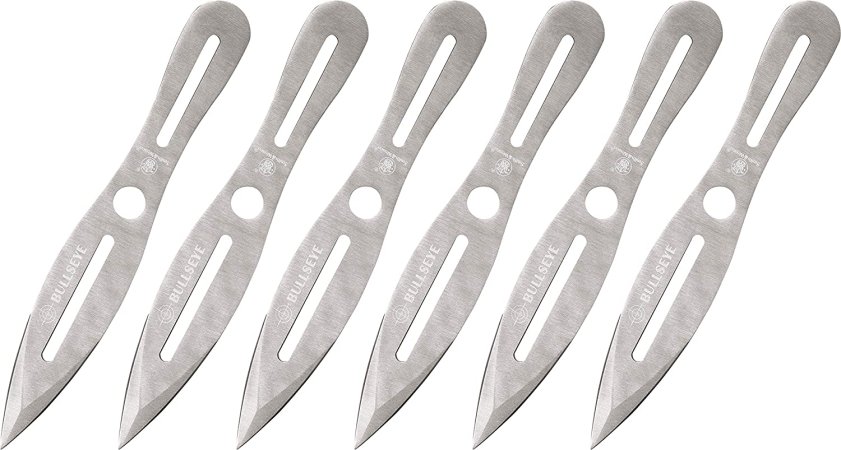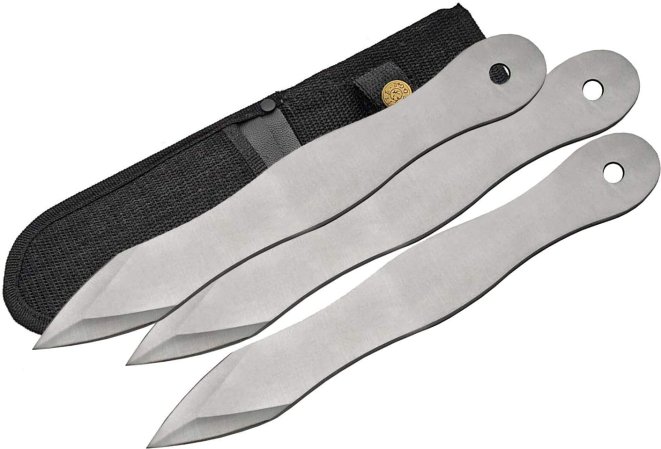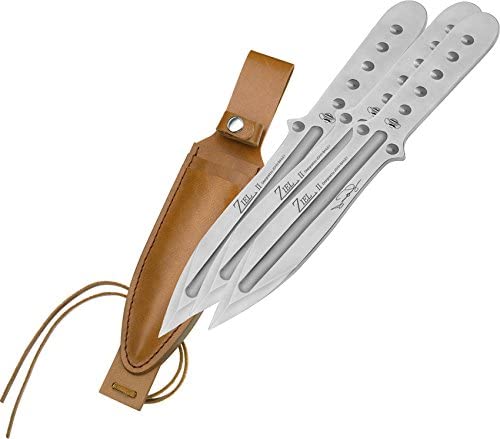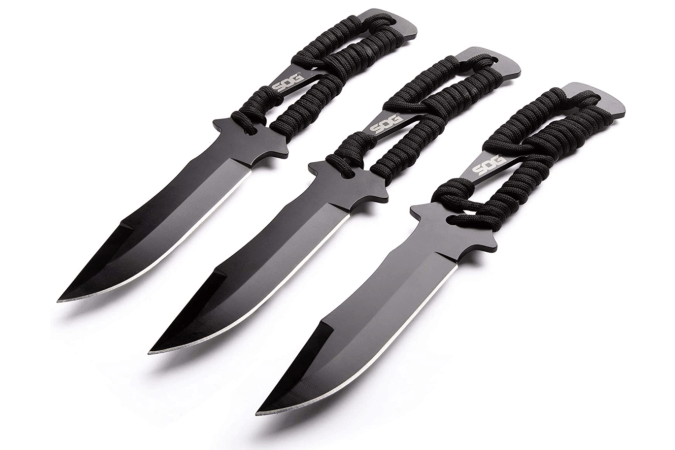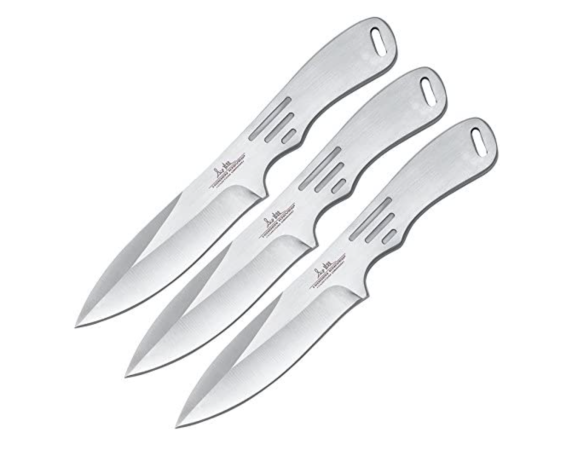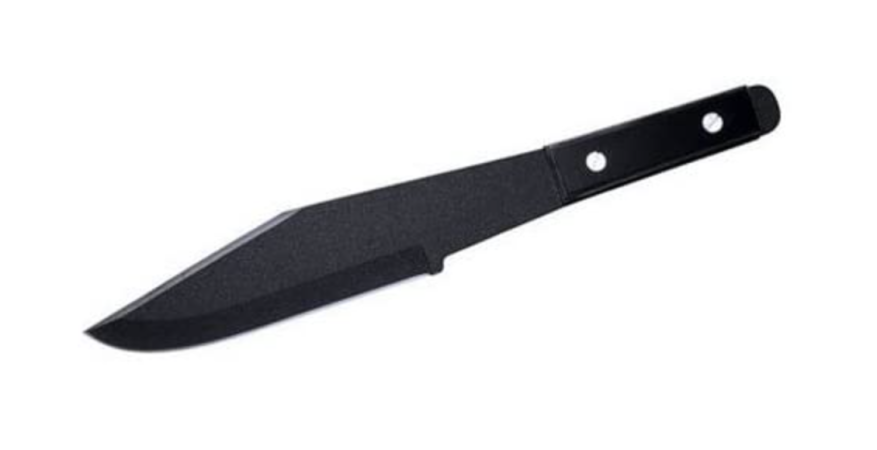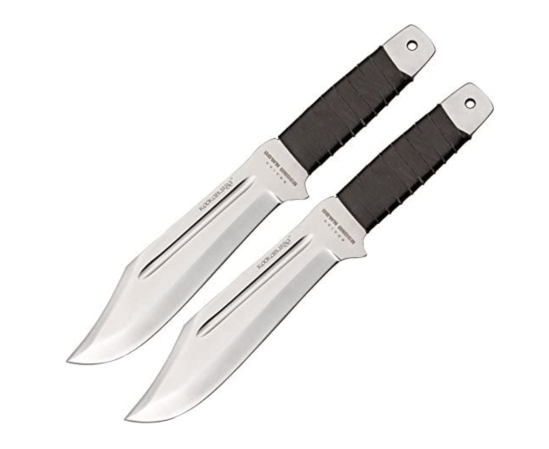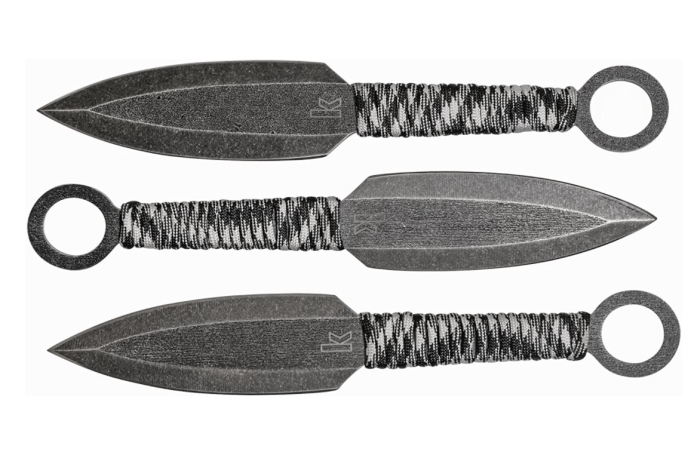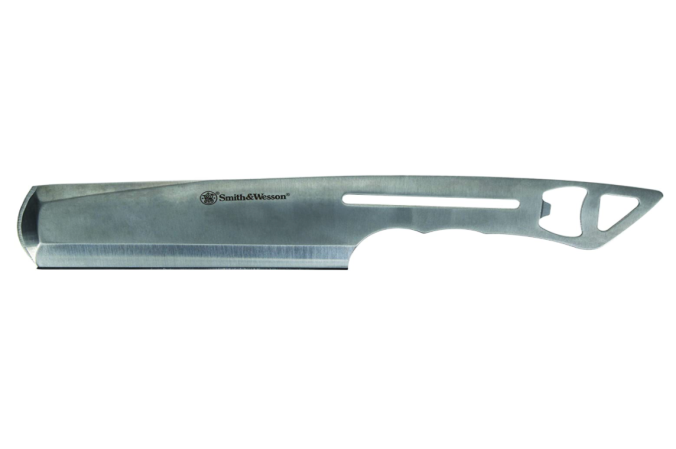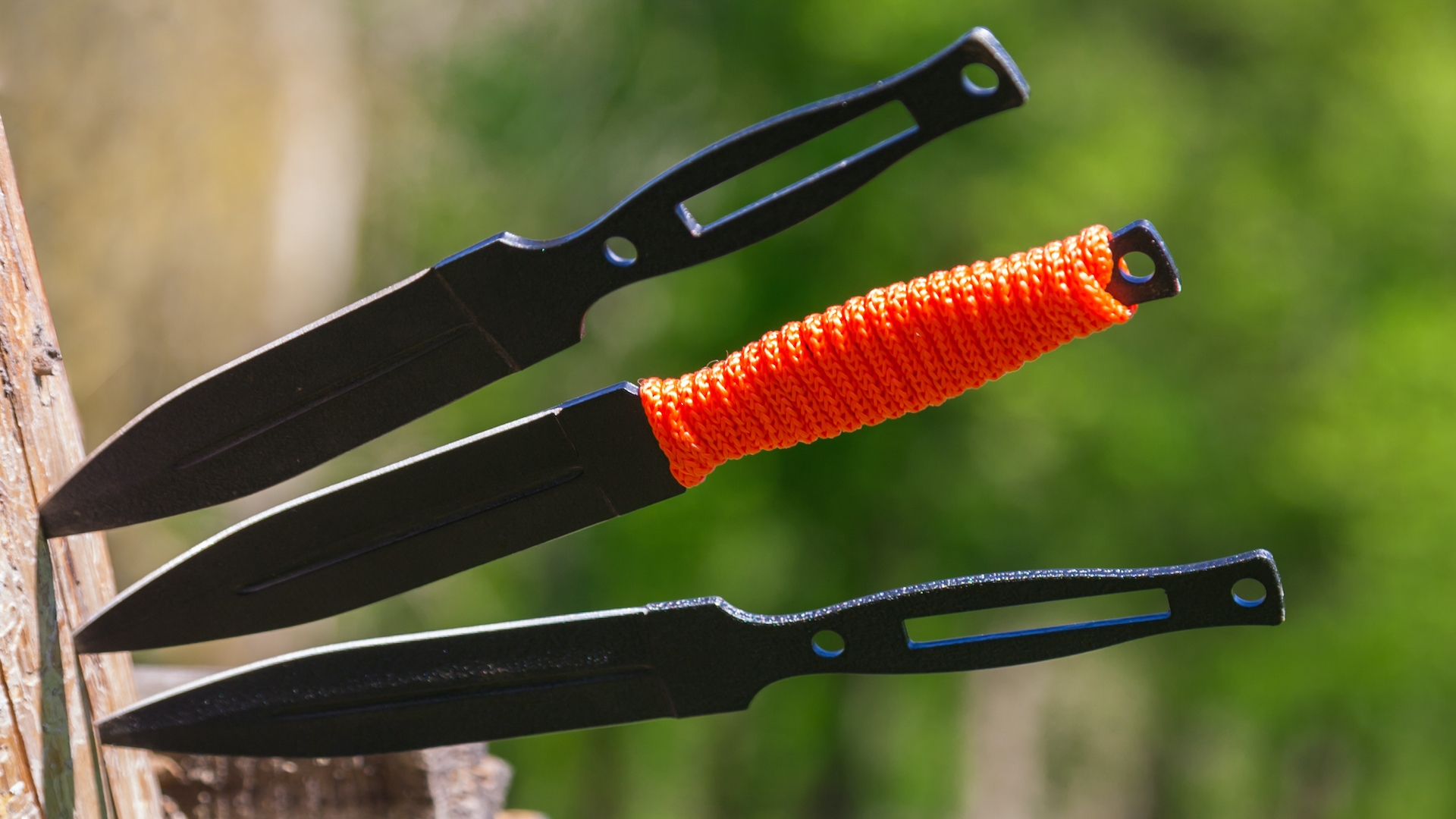

We may earn revenue from the products available on this page and participate in affiliate programs.
Nothing says “operator” like throwing knives at a target to blow off steam at the end of a rough day. OK, so a 19-year-old recruit fresh out of basic may not be anywhere close to being an operator, but even a newly-minted Space Force guardian can start sticking logs with a quality set of throwing knives, some instruction, and a little bit of patience.
Throwing knives is an age-old pastime with a history reaching back millennia. Unlike more recent military traditions such as slapping challenge coins onto a bar, warriors of all kinds have been launching knives through the air in combat, at backyard targets, and everywhere in between, further adding to the practice’s honor and tradition. In fact, this has us wondering if maybe the Army Marksmanship Unit needs to start expanding its horizons.
To help you get started, we’ve rounded up some of the best throwing knives on the market. And remember: the enemy cannot push a button if you disable his hand.
Best Overall
Smith u0026 Wesson SWTK8 Bullseye Throwing Knife Set
Pros
- Good length and balance
- Lightweight
- Made with impact-resistant high-carbon steel
- Includes six knives
Cons
- Susceptible to wind while in flight
- May have sharp edges that need sanding
Product Specs
- Blade steel: 2Cr13 stainless steel
- Weight: 4.7 ounces
- Length: 8 inches
Best Value
SZCO Supplies Heavy Throwing Knife Set
Pros
- Affordable
- Good length and balance
- Great for beginners
- Made with thick, tough steel
Cons
- Set only includes three knives
Product Specs
- Blade steel: 3CR13 stainless steel
- Weight: 9 ounces
- Length: 10 inches
Editor's Choice
Boker Magnum Bailey Ziel Set
Pros
- Meets or exceeds throwing club requirements
- Excellent balance and release
- Leather sheath
- Limited lifetime warranty
Cons
- Expensive
- Might be a little long for some throwers
- Set only includes three knives
Product Specs
- Blade steel: 420J2 stainless steel
- Weight: 14 ounces
- Length: 13.25 inches
Most Aggressive Throwing Knives
SOG Clip Point Throwing Knives
Pros
- Versatile, sharpened blade
- Good length and balance
- Lightweight
- Appealing aesthetic
Cons
- A little pricey
- Sharpened edge could be dangerous for new throwers
- Susceptible to wind while in flight
Product Specs
- Blade steel: 420 stainless steel
- Weight: 5 ounces
- Length: 10 inches
Best Sharpened Throwing Knives
United Cutlery Gil Hibben Large Triple Throwing Knife Set
Pros
- Versatile, sharpened blade
- Excellent balance
- Lightweight
- Snap-secured nylon sheath
Cons
- Set only includes three knives
- Sharpened edge could be dangerous for new throwers
- Susceptible to wind while in flight
Product Specs
- Blade steel: 420 stainless steel
- Weight: 5.25 ounces
- Length: 8.625 inches
Best Large Throwing Knife
Cold Steel Perfect Balance Thrower
Pros
- Versatile
- Great balance
- Rust-resistant finish
- Tough and durable
Cons
- Expensive
- Heavy
- Sheath and extra knives not included
Product Specs
- Blade steel: 1055 carbon steel
- Weight: 15.4 ounces
- Length: 13.5 inches
Most Versatile Throwing Knife
Down Under Knives Kookaburra Throwing Knife
Pros
- Versatile
- Leather-wrapped handle
- Durable
Cons
- Very expensive
- Set only includes two knives
Product Specs
- Blade steel: Heat-treated 440C stainless steel
- Weight: 12.7 ounces
- Length: 12 inches
Best Throwing Dagger
Kershaw Ion Throwing Daggers
Pros
- Very lightweight
- Sharpened, dual-edged blade
- Great aesthetic
Cons
- Sharpened edge could be dangerous for new throwers
- Susceptible to wind while in flight
- Set only includes three knives
Product Specs
- Blade steel: 3Cr13 stainless steel
- Weight: 4 ounces
- Length: 9 inches
Best Throwing Cleaver
Smith u0026 Wesson Bullseye 10” Throwing Cleaver
Pros
- Fun aesthetic
- Sharpened front edge
- Convenient bottle opener in handle
- Snap-secured nylon sheath
Cons
- Sharpened edge could be dangerous for new throwers
- Set only includes three knives
Product Specs
- Blade steel: 3Cr13 stainless steel
- Weight: Not listed
- Length: 10 inches
Why you should trust us
Ever since elementary school, I have lived and breathed knives of one kind or another. It all started with the Old Timer Mighty Mite I received for my eighth birthday, and it’s all gone downhill since. Now, I can’t get enough of knives and other blades. In addition to building my own collection of pocket knives, fixed blades (including throwing steel), and tomahawks, I have sacrificed blood, toil, tears, and sweat for you, dear reader, reviewing knives of all shapes and sizes for their efficacy and have even gone so far as to dive into the deep mysteries of Damascus steel.
Types of throwing knives
To the untrained eye, all throwing knives look mostly alike. Sure, one may have an extra curve here or a skeletonized handle there, but besides those nuanced differences, what’s the big deal? A knife’s a knife, right? Wrong, actually. While most knives look quite similar, all throwing knives can be divided into two separate categories: throwing knives and throwing daggers. While the differences may be relatively small, both categories have their own distinctive features and uses.
Throwing knives
Most throwing knives fall into the category of the traditional knife pattern. Unlike traditional knives, throwing knives often lack sharp edges for safer handling, and their points, while still sharp, may be to be slightly blunted by comparison. That said, some throwing knives do include sharpened blades, although such knives are single-edged, further adhering to the traditional knife pattern.
Throwing knives regularly come in both single-edge and dual-edge patterns and commonly use a spear, clip point, or leaf blade pattern. In addition, throwing knives occasionally take on a unique form factor by employing a unique blade pattern, such as a Bowie-style clip point or a kitchen cleaver (with a beveled or sharpened front edge to ensure your throws stick).
Throwing daggers
The throwing dagger is the next evolution of the throwing knife. Both designs rely on the same basic principles of weight and balance, but the longer, heavier throwing dagger uses a triangular spear point blade with straight lines that lend it an aggressive aesthetic.
Almost without exception, throwing daggers are double-edged, and sharpened daggers always are. Often, throwing daggers feature slim, even rodlike handles capped by a large ring. At times, the handle will feature a paracord wrap or similar lightweight gripping surface, enhancing both your grip and the blade’s overall aesthetic. It’s no wonder this knife style co-starred with Jason Statham in The Expendables franchise.
Key features of throwing knives
As with any knife, many factors go into the making of a quality blade, but as with traditional knives, tomahawks, and other bladed tools, throwing knives have their own unique set of features that make them capable of handling the stress and abuse that come their way. When selecting a throwing knife, make sure to take a close look at its blade steel, weight, length, balance, and handle. From an objective standpoint, little else matters.
Blade Steel
No matter how hard you may try to avoid it, your throwing knives will endure tons of abuse, as in sentry-duty-soldier’s-destructive-fantasies-coming-true levels of abuse. A quality throwing knife is capable of enduring the kind of field-developed torture tests that many traditional knifes blades would easily fail.
Traditionally, top-quality knife blades tend to be tough, hardened customers capable of holding an edge well, yet these same blades could chip, crack, or break under impact stresses. As such, look for throwing knives made of softer steels, such as 1075 carbon steel, 2Cr13 stainless steel, or spring steel. If possible, find your desired blade’s Rockwell hardness rating. Ideally, it’ll be somewhere in the ballpark of 45-50 HRC/RC.
Weight
A throwing knife’s weight directly affects how the knife is thrown. Knife-throwing legend Harry K. McEvoy recommended that beginners look for knives somewhere in the ballpark of one ounce (30 grams) per inch of the knife’s overall length, as lighter blades are more susceptible to being blown off course in flight. For knife-throwing veterans, this is particularly helpful advice, but admittedly, not everyone who picks up such a knife really knows what they’re doing.
Sometimes, it’s best to go with a knife that doesn’t weigh quite so much. Lighter knives may be a better option for younger knife throwers or those with smaller or weaker hands and wrists. Thankfully, many throwing knives tip the scales at less than 0.75 ounces per inch of length, making them a whole lot easier to use, albeit at shorter ranges on gusty days.
Length
Even if you flunked physics (or never even took it), its laws still apply to the world of blade throwing. While it may seem strange at first, a knife’s length can dramatically affect a thrower’s ability to hurl the blade toward a target. Longer blades are easier to throw, as they slow the blade’s rotation rate to a level that is more forgiving of imperfect throws.
Most throwing blades range between eight and 10 inches long, although some suggest beginners use even longer knives, such as a 12-incher. While a longer knife might add a little additional weight, the extra length tends to minimize the effects of the extra weight.
Balance
A knife’s balance describes the center of mass within a given blade, a simple yet critical consideration for knife throwers. As the description implies, balance describes the location of a knife’s center of gravity along its length. A properly balanced knife is easy to throw, while an improperly balanced knife will be difficult to throw with any degree of consistency or accuracy.
A well-balanced blade has its center of mass located in the middle of the knife, making it an excellent choice for new and casual throwers. Blade-heavy and handle-heavy knives transfer their weight to those respective portions of the knife, dramatically affecting how the knife performs as it travels through the air.
Handle
When selecting a knife, consider the handle and its layout. As a throwing knife leaves your hand, the steel will slide along your fingers which affects your release and accuracy. For new throwers and those who go hard on their equipment, a handle with few to no cutouts will tend to stand up best to regular drops, misses, and other impacts.
A skeletonized handle makes for a lighter knife and/or a blade-heavy knife, but they may be less resistant to constant abuse. If you have limited experience, consider picking up a solid-handled knife. Some knives also include a paracord-wrapped handle, although these wraps often fail relatively quickly.
Benefits of throwing knives
While ax throwing has gained plenty of popularity among millennials, knife throwing is the art original form, and it requires an extra level of skill and finesse to achieve success. Sure, hurling axes at a sawed-off tree stump (or foam target) can look impressive, but sticking a knife into a target with repeatable accuracy can be incredibly rewarding.
Affordable fun
One of Google’s FAQs on the subject of knife throwing is, in essence, “what’s the point?” Let’s start with entertainment. There’s something fun, oddly satisfying, and even addicting about sticking a pointy piece of metal into a solid piece of wood over and over and over again. Better yet, knife throwing is a hobby you can learn with your buddies or your significant other with little effort (but maybe a good bit of patience).
Everyone needs to blow off steam every once in a while, preferably in a non-destructive way. Hobbies are a great way to relieve stress, although some are a bit pricier than others. Compared to modding cars, off-roading, and shooting, knife throwing is an incredibly inexpensive hobby that anyone can enjoy without worrying about putting a dent in their pocketbook.
Enhanced mental capabilities
Knife throwing, unlike some pursuits, can do wonders for your personal development. In other words, sticking pointy metal slabs into a lump of wood can help you grow. Who knew, right?
Due to the patience and precision necessary to land your blade in the target time and again, knife throwing is an excellent way to boost your confidence, discipline, and focus. Confidence comes from knowing you can consistently deliver precise hits on target whenever challenged. Knife throwing helps you develop discipline by demanding patience and dedication to develop your consistency and precision, a valuable asset in any high-stakes situation. Lastly, knife throwing proficiency comes from enhancing your ability to tune out distractions and keep your eye on the prize, all in the name of fun and bragging rights.
Pricing considerations for throwing knives
Throwing knife pricing can be somewhat confusing to gauge due to the fact that these blades usually come in sets of three, six, or a dozen, although a few, usually pricier options can be purchased individually. As such, we recommend using the price per knife to determine the best deal.
Budget
Unlike more utilitarian knives, throwing knives often use softer, more flexible steels due to the unique demands and stresses that such knives must endure. Thankfully, such steels cost a good bit less than other knife steels, making it easy to get started in the sport of knife throwing without breaking the bank.
Many starter sets come with low-end blades that use a soft steel that blunts easily and cost less than $5 per knife, but in many cases, we recommend avoiding these blades, mostly due to low durability, poor tip retention, and/or off-center balance. Good entry-level throwing blades usually run in the $6 to $10 range for a single knife, although they usually come in sets of three which will cost you somewhere between $20 to $30. Start here, and you should be good to go.
Mid-range
In most cases, a price tag between $10 to $30 per throwing knife is the sign of a good, reliable blade. High-quality throwing knives from mass-market manufacturers cost more than $10 per blade, often hitting between $25 and $30 apiece.
These blades tend to be skeletonized, making them a better choice for gentler, more precise throwers. At this price point, you will start to see 420 stainless steel blades and the occasional snap-secured or leather sheath. Paracord handle wrappings also appear fairly often at this price point, although many of them lack durability. Most often, these blades are available in sets of three, although solo offerings do appear from time to time.
Premium
On rare occasions, you may stumble across a single throwing knife priced at or above $30, but such blades are very uncommon. Compared to most other throwing knives, these are in a league of their own. Often, these knives feature sharpened edges which may be intended to double as a more traditional knife. The knives may include handle scales and are almost always sold solo.
Common blade steels in the price bracket include 420 series stainless steel, such as 420C, and 1055 carbon steel. Some of these blades are also heat-treated which increases their edge retention but, on the flip side, may increase their likelihood of breaking if thrown poorly.
How we chose our top picks
When reviewing new gear, we much prefer to go the hands-on route, but sometimes, a lack of resources may thwart our attempts to get our mitts on some cool gear. To make sure we don’t let you down, we take the time to listen to those who have firsthand experience, combing through reviews on Amazon, professional publications, enthusiast blogs, and more to bring you the best intel available. We sift through it all, keep the gold, and toss the rest.
To complete this throwing knives guide, we did some extensive research to make sure we found the best the market has to offer. We gleaned some valuable information from A.G. Russell, American Knife Throwers Alliance, Axeing.org, Blade HQ, and Knife Informer and recommend you check out what they had to say.
FAQs on throwing knives
You’ve got questions, Task & Purpose has answers.
Q: How much do throwing knives cost?
A: A good quality throwing knife usually runs around $10 a pop, but since most purpose-built throwing knives come in sets of three or more, you can expect to drop somewhere in the neighborhood of $30 for a decent set.
Q: Can any knife be a throwing knife?
A: Technically, yes. That said, if you want to hit your target with any degree of consistency or accuracy, skip the Bowie knife, the karambit, and any other knife that isn’t built for throwing. Your knives will also last longer if you go with a purpose-built blade since traditional knives break more easily during high-speed impacts with solid objects.
Q: Which knife is best for throwing?
A: If you plan to throw often, find throwing knives that are tough, lightweight enough for you, and have a good balance. Knives in the eight to 12-inch range are a great option, especially for beginners.
Q: What is a good distance for throwing knives?
A: This depends on what kind of knife you are throwing, what size your knife is, and what technique you use (spin vs. no-spin techniques). In competitive knife throwing, standard distances are 10 and 15 feet. For newbies, though, a good distance usually ranges between eight and 15 feet, again, depending on your chosen knife and technique.
Q: Are throwing knives good for self defense?
A: I don’t care how feasible Hollywood makes it look, relying on a throwing knife to save your life is foolhardy. Even if you manage to stick your assailant in the perfect spot, he won’t drop then and there since he’s already amped up on adrenaline (or meth). That’s bad news for you, especially if he’s armed.
Our gear section
For over 25 years, Brian Smyth has been neighbors with the Air Force Academy and the U.S. Army’s Ivy Division. He loves the challenge of crafting words and has written for The Drive, Car Bibles, and other publications. Nothing gets him going quite like the roar of dual Pratt & Whitneys overhead, the smell of cordite, and the stories of the Greatest Generation.
